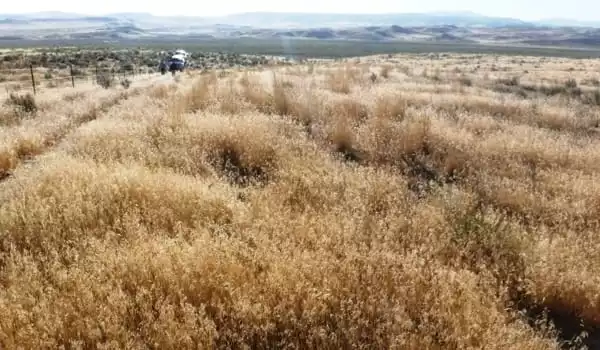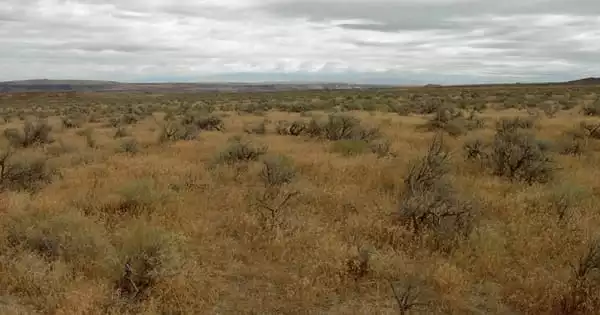No one likes a cheater, especially one that thrives as easily as the grass Bromus tectorum does in the American West. This invasive species is known as cheatgrass because it dries out faster than native plants, depriving wildlife and cattle of essential food.
Unfortunately for those creatures and the crowded-out native plants, cheatgrass and several other invasive annual grasses now dominate one-fifth of the Great Basin, a large stretch of territory that includes parts of Oregon, Nevada, Idaho, Utah, and California. Researchers estimate in Diversity and Distributions on November 17 that by 2020, these invasive grasses will have occupied more than 77,000 square kilometers of Great Basin ecosystems, including higher elevation habitats that are now accessible to nonnative plants due to climate change.
This exotic annual grass invasion is destroying one of North America’s most threatened biomes: a wide sea of sagebrush shrubs, wildflowers, and bunchgrasses where pronghorn and mule deer graze and ranchers rely on healthy rangelands to rear cattle.
Furthermore, because these exotic grasses are very flammable when dry, they are connected to more frequent and larger wildfires. Fires are increasingly occurring every three to five years in portions of Idaho’s Snake River Plain that are dominated by cheatgrass, as opposed to the historical average of 60 to 110 years. Cheatgrass was linked to 39 of the Great Basin’s 50 greatest fires between 2000 and 2009.
Rather than always chasing the problem, we need to get strategic spatially to define where to maintain intact native plant communities. In a lot of ways, invasive grasses just do an end run around perennials. They don’t have to deal with the harshest effects of climate change because of their different life cycle.
Joseph Smith
To make matters worse, cheatgrass is more effective than native plants in recolonizing burned areas after a fire, creating a vicious cycle in which more cheatgrass causes more fires, and more fires promote more of the weeds. This means that land managers are frequently behind the curve, working to avoid cheatgrass from spreading in order to prevent wildfires while also attempting to restore native plant communities after fires so that sagebrush ecosystems do not become a monoculture of invasive grasses.
“Rather than always chasing the problem, we need to get strategic spatially to define where to maintain intact native plant communities,” says Joseph Smith, a rangeland ecology researcher at the University of Montana in Missoula.
To do so, Smith and his colleagues calculated how much of the Great Basin had been converted to invasive annual grasses during the last three decades. The researchers employed the Rangeland Analysis Platform, or RAP, a remote sensing program powered by Google Earth Engine that predicts the type and proportion of vegetation on a baseball diamond scale.

While the satellite imagery on which RAP is based can reveal where annual grasses turn brown in late spring in the West or where perennial plants stay green longer into the summer, the technology cannot distinguish between native and nonnative species. As a result, researchers cross-checked RAP data with on-the-ground vegetation surveys acquired under the US Bureau of Land Management’s assessment, inventory, and monitoring plan.
The scientists discovered that invasive annual grasses had grown eightfold in the Great Basin region since 1990. Smith and colleagues estimate that grass-dominated areas have expanded by more than 2,300 square kilometers each year, a rate of take-over that is proportionally greater than recent Amazon rainforest deforestation.
Perhaps most concerning, the researchers discovered that annual grasses, the majority of which are invasive, are progressively creeping into higher elevations previously assumed to be immune to invasion. Invasive annual grasses are not as hardy as native perennial plants in cold, snowy winters. However, as a result of climate change, winters in the Great Basin are becoming milder and summers more drier. While perennial plants are struggling to survive the hot, dry months, invasive grass seeds simply lie dormant and wait for fall rains.
“In a lot of ways, invasive grasses just do an end run around perennials. They don’t have to deal with the harshest effects of climate change because of their different life cycle,” Smith explains.
Though the scale of the problem can seem overwhelming, free remote sensing technology like RAP may help land managers better target efforts to slow the spread of these invasive grasses and explore their connection to wildfires. Smith, for instance, is now researching how mapping annual grasses in the spring might help forecast summer wildfires.
“If we don’t know where the problem is, then we don’t know where to focus solutions,” says Bethany Bradley, an invasion ecologist and biogeographer at the University of Massachusetts Amherst who wasn’t involved in the research. “Mapping invasive grasses can certainly help people stop the grass-fire cycle by knowing where to treat them with herbicides.”





